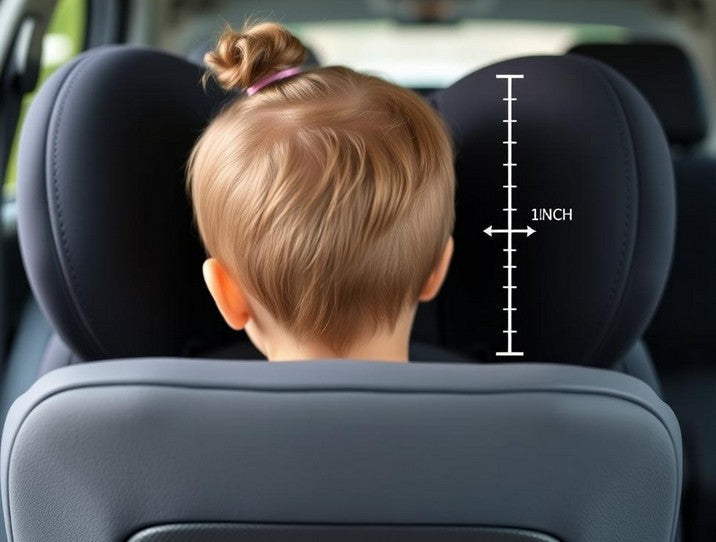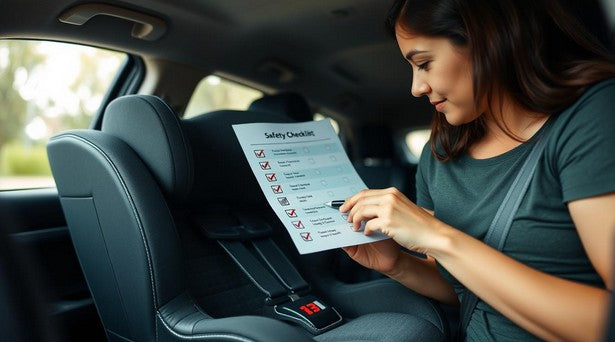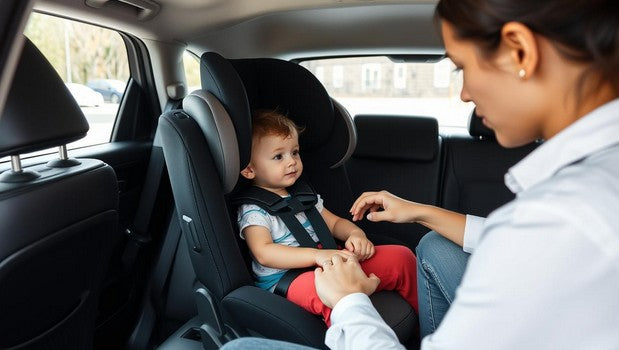As parents, few decisions feel as consequential as those affecting your child's safety. The choice between rear-facing and forward-facing car seats represents one of these critical decisions. With conflicting advice from well-meaning family members and confusing information online, it's easy to feel overwhelmed. This comprehensive guide cuts through the noise with evidence-based information on car seat safety, helping you make the best choice for your child's protection on every journey.
Why Rear-Facing Reduces Injury Risk by 75%
The physics behind car seat safety is compelling. In a frontal collision—the most common type of serious crash—a rear-facing car seat cradles your child's head, neck, and spine, distributing crash forces across their entire back. This significantly reduces the risk of serious injury compared to forward-facing positions.
Crash test data visualization: Force distribution in rear-facing (left) vs. forward-facing (right) positions
According to crash test data and real-world accident analysis, rear-facing car seats reduce serious injury risk by up to 75% compared to forward-facing seats for children under age 2. This dramatic difference occurs because:
- A child's head makes up 25% of their body weight (compared to 6% for adults)
- Young children's neck muscles and spine are still developing and vulnerable
- The spinal cord can stretch only ¼ inch while the spinal column can stretch up to 2 inches
- Rear-facing positions prevent the dangerous whiplash motion that can cause spinal injuries
"The rear-facing position allows the car seat to absorb most of the crash forces while supporting the head, neck, and spine. When children ride forward-facing, their heads—which are relatively large and heavy for their bodies—are thrown forward in a crash, putting stress on the neck and spinal cord."
— American Academy of Pediatrics
The Physics of Protection: How Car Seats Work in a Crash
Rear-Facing Dynamics
In a frontal collision, a rear-facing seat works by:
- Cradling the child's body, similar to catching a baseball in a mitt
- Distributing crash forces across the entire back and shoulders
- Keeping the head, neck, and spine aligned in a straight line
- Allowing the child to "ride down" the crash in a controlled manner
Forward-Facing Limitations
By contrast, a forward-facing seat:
- Restrains the body with harness straps at contact points
- Cannot prevent the head from being thrown forward
- Creates stress on the neck as the heavy head moves forward
- Concentrates forces on the areas where harness contacts the body
What About Rear-End Collisions?
A common concern is how rear-facing seats perform in rear-end crashes. Research and real-world data show that rear-facing seats still provide excellent protection in these scenarios. Modern car seats are designed to absorb and manage crash forces from multiple directions. Studies confirm that children in rear-facing seats typically fare well in rear-impact collisions.
When Is It Safe to Switch? Developmental Milestones
The decision to transition from rear-facing to forward-facing should be based on your child's size and development, not just age. However, these guidelines provide a solid framework:
|
Age Range |
Weight Range |
Height Considerations |
Recommendation |
|
Birth-12 months |
Any weight |
Any height |
Always rear-facing - no exceptions |
|
1-2 years |
Up to seat limit |
Up to seat limit |
Rear-facing strongly recommended by AAP and NHTSA |
|
2-4 years |
Up to 40-50 lbs |
Until 1" below top of seat |
Rear-facing preferred as long as within seat limits |
|
4+ years |
Exceeds rear-facing limit |
Exceeds rear-facing limit |
Forward-facing with harness until booster ready |
Important: The American Academy of Pediatrics (AAP) and National Highway Traffic Safety Administration (NHTSA) recommend keeping children rear-facing as long as possible, until they reach the maximum height or weight limit of their car seat.
5 Signs Your Child Is Ready to Face Forward
Your child is ready to transition to forward-facing only when:
- They have reached at least 2 years of age (minimum)
- They have reached the maximum weight limit for rear-facing in their specific car seat (typically 40-50 pounds)
- Their head is less than 1 inch from the top of the car seat in the rear-facing position
- They meet the minimum forward-facing requirements for your specific car seat model
- You've consulted your car seat manual for model-specific transition guidelines
The "1-inch rule": A child should have at least 1 inch of space between the top of their head and the top of the car seat in rear-facing position
Decision Flowchart: Is Your Child Ready to Face Forward?
Use this interactive flowchart to determine if your child should remain rear-facing or transition to forward-facing:
Need Personalized Guidance?
Still unsure if your child is ready to transition? Find a certified Child Passenger Safety Technician near you for a professional evaluation.
Debunking Common Myths About Rear-Facing Safety
MYTH: "My child's legs are cramped rear-facing, so it must be uncomfortable and unsafe."
FACT: Children are naturally more flexible than adults and find cross-legged or "frog-leg" positions comfortable. There are ZERO documented cases of children breaking their legs due to rear-facing positioning. Ironically, leg injuries are more common in forward-facing positions during crashes.
Children naturally find positions that are comfortable for them in rear-facing seats
MYTH: "Rear-facing is dangerous in rear-end collisions."
FACT: Studies and real-world crash data show that rear-facing car seats effectively protect children in rear-end collisions. Modern car seats are designed to absorb and manage crash forces from multiple directions.
MYTH: "My child can turn forward-facing at 1 year and 20 pounds."
FACT: This outdated guideline has been replaced. Current recommendations from the AAP and NHTSA advise keeping children rear-facing until at least age 2, and preferably longer until they reach the maximum height or weight limits of their rear-facing seat.
MYTH: "My child is big for their age, so they can face forward sooner."
FACT: Larger children actually benefit more from rear-facing positions. Their heavier heads and bodies create more force in a crash, making spine and neck protection even more critical.
Top 3 Rear-Facing Car Seats for 2025
Based on safety ratings, ease of use, and extended rear-facing capabilities, these car seats stand out as top choices for keeping your child rear-facing longer:
Graco Extend2Fit Convertible
Price Range: $199-$249
Rear-Facing Limits: 4-50 lbs, up to 49 inches
Key Features:
- 4-position extension panel adds 5" of legroom
- 10-position headrest for growing children
- Simple LATCH installation system
- Steel-reinforced frame for durability
Why We Love It: The Extend2Fit offers one of the highest rear-facing weight limits (50 lbs) on the market, allowing most children to remain rear-facing until age 4 or beyond. The extendable panel provides extra legroom for comfort without compromising safety.
Britax Marathon ClickTight
Price Range: $299-$349
Rear-Facing Limits: 5-40 lbs, up to 49 inches
Key Features:
- ClickTight installation system for secure fit
- SafeCell Impact Protection system
- Steel frame and impact-absorbing base
- Quick-adjust 14-position harness
Why We Love It: The Marathon's ClickTight system makes proper installation nearly foolproof—a critical safety factor since incorrect installation reduces protection. Its steel frame and multiple layers of side impact protection provide exceptional crash performance.
Nuna RAVA Convertible
Price Range: $449-$499
Rear-Facing Limits: 5-50 lbs, up to 49 inches
Key Features:
- Simply secure installation with belt tensioning
- No flame retardant chemicals in fabrics
- Extended leg room with adjustable positioning
- Side impact protection pods
Why We Love It: The premium RAVA combines exceptional safety with luxury comfort and chemical-free materials. Its innovative design allows for extended rear-facing use while providing more legroom than most competitors. The true tension doors make installation simple with either LATCH or vehicle belt.
Safety Note: Even the best car seat must be installed correctly to provide maximum protection. According to NHTSA, approximately 46% of car seats and booster seats are installed incorrectly, reducing their effectiveness in a crash.
Installation Tips for Maximum Safety
Rear-Facing Installation Essentials
- Ensure the car seat is reclined at the correct angle for your child's age (more reclined for infants, more upright for older babies)
- Check that the seat doesn't move more than 1 inch side-to-side or front-to-back when pulled at the belt path
- Position harness straps at or below shoulder level
- Verify the chest clip is at armpit level
- Remove bulky clothing before securing your child
Forward-Facing Installation Essentials
- Always use the top tether strap when installing forward-facing
- Position harness straps at or above shoulder level
- Ensure the seat doesn't move more than 1 inch when tested at the belt path
- Follow weight limits for LATCH installation (typically 65 lbs combined child + seat weight)
- Switch to seat belt installation when LATCH limits are exceeded
Key differences in proper installation: rear-facing (left) vs. forward-facing (right)
Get Your Car Seat Checked
Even experienced parents benefit from professional installation checks. Find a certified Child Passenger Safety Technician near you for a free inspection. Find Inspection Locations
State Laws and National Recommendations
While safety physics remain the same everywhere, legal requirements vary by state. As of 2025, these states require children to remain rear-facing until at least age 2:
- California
- Connecticut
- Illinois
- Louisiana
- Maine
- Nebraska
- New Jersey
- New York
- Oklahoma
- Oregon
- Pennsylvania
- Rhode Island
- South Carolina
- Virginia
- Washington
"Your child should remain in a rear-facing car seat until he or she reaches the top height or weight limit allowed by your car seat's manufacturer."
— National Highway Traffic Safety Administration (NHTSA)
"All infants and toddlers should ride in a rear-facing car safety seat as long as possible, until they reach the highest weight or height allowed by their car safety seat's manufacturer."
— American Academy of Pediatrics (AAP)
Remember: State laws represent the minimum requirements for legal compliance. For maximum safety, follow the AAP and NHTSA recommendations to keep your child rear-facing as long as possible, regardless of your state's minimum requirements.
Frequently Asked Questions
What if my child already rides forward-facing? Should I switch them back?
Yes, if your child is under 2 years old or still within the rear-facing limits of their car seat, safety experts recommend switching back to rear-facing. While there may be some initial resistance, most children adapt quickly, and the safety benefits are significant. Many parents report that after a brief adjustment period, their children are perfectly content riding rear-facing again.
How can I keep my rear-facing child entertained when I can't see them?
By 9-12 months, children understand you're present even when they can't see you. Talk, sing, and play verbal games with your child. For older rear-facing children, secure toys to the seat, use backseat mirrors to make eye contact, or consider mounting a tablet for longer trips (ensuring it's securely attached and positioned safely).
What about motion sickness? Won't forward-facing help?
Research shows that most children who experience motion sickness will have it regardless of seating position. If your child suffers from motion sickness, try these strategies: ensure good ventilation, avoid reading or screen time in the car, provide a small snack before travel, keep trips short when possible, and schedule breaks for longer journeys. Consult your pediatrician about appropriate motion sickness remedies if symptoms are severe.
My child's feet touch the vehicle seat back. Isn't this uncomfortable or unsafe?
Children are naturally more flexible than adults and find positions that are comfortable for them. They can easily sit cross-legged or with their legs up on the seat back. There are zero documented cases of children breaking their legs due to rear-facing positioning. In fact, leg injuries are more common in forward-facing positions during crashes as the child's legs can strike the front seat.
What if my child outgrows their infant seat before age 2?
This is common and expected! Infant-only seats are typically outgrown between 9-12 months. When this happens, transition to a convertible car seat installed in the rear-facing position. Convertible seats have higher height and weight limits that will accommodate your child rear-facing well beyond age 2, often until age 4 or older.
Many children can remain comfortably rear-facing until age 4 or beyond in convertible seats
Additional Resources
Official Guidelines
Installation Help
- Find a Car Seat Inspection Station
- Locate a Child Passenger Safety Technician
- NHTSA Installation Videos
Car Seat Registration
Stay Informed About Car Seat Safety
Sign up for recall notifications and safety updates from NHTSA to ensure your child's car seat remains safe. Subscribe to Safety Updates
Making the Safest Choice for Your Child
The evidence is clear: rear-facing car seats provide superior protection for young children. By keeping your child rear-facing as long as possible—until they reach the maximum height or weight limits of their car seat—you're providing them with the best possible protection in the event of a crash.
Remember that each transition—from rear-facing to forward-facing, from harnessed seat to booster, and from booster to seat belt—reduces the level of protection. There's no rush to move forward. When it comes to car seat transitions, later is safer.
By understanding the physics behind car seat safety and following evidence-based guidelines rather than minimum legal requirements or well-meaning but outdated advice, you're making a choice that could literally save your child's life.
The most important car seat is the one that's properly installed and used correctly every time




Leave a comment
This site is protected by hCaptcha and the hCaptcha Privacy Policy and Terms of Service apply.